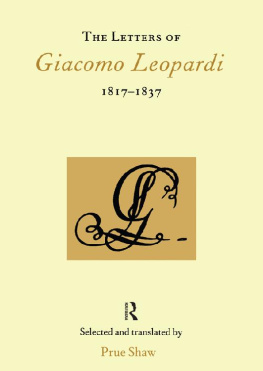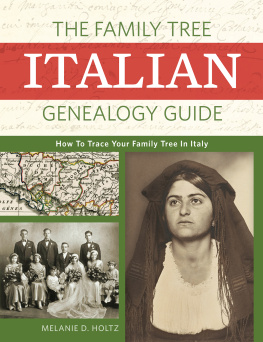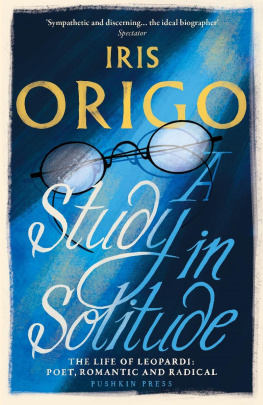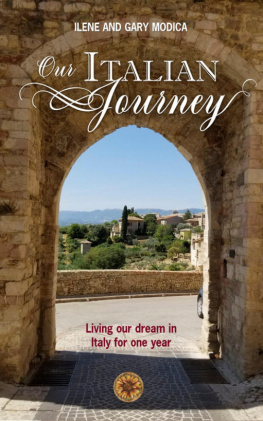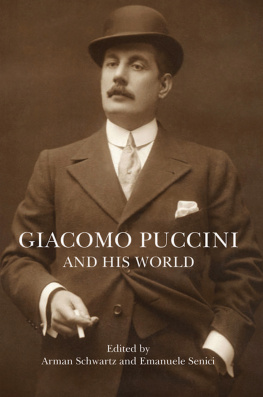In the light of growing academic interest in Italy and the re-organization of many university courses in Italian along interdisciplinary lines, this book series aims to bring together different scholarly perspectives on Italy and its culture.
The Letters of Giacomo Leopardi 1817-1837
Selected and translated by
Prue Shaw
1998
For Claerwen and Lucinda
ITALIAN PERSPECTIVES 1
First published in 1998 by Northern Universities Press
Published 2017 by Routledge
2 Park Square, Milton Park, Abingdon, Oxon OX14 4RN
711 Third Avenue, New York, NY 10017, USA
Routledge is an imprint of the Taylor & Francis Group, an informa business
1998 Prue Shaw. The moral right of the author has been asserted.
Figures 4, 6 and 7 are reproduced by kind permission of the Ministero per i Beni Culturali e Ambientali; figures 1, 2, 3 and 5 by kind permission of Contessa Anna Leopardi.
All rights reserved. No part of this book may be reprinted or reproduced or utilised in any form or by any electronic, mechanical, or other means, now known or hereafter invented, including photocopying and recording, or in any information storage or retrieval system, without permission in writing from the publishers.
Notice:
Product or corporate names may be trademarks or registered trademarks, and are used only for identification and explanation without intent to infringe.
ISBN 13: 978-0-901286-97-0 (pbk)
ISSN: 1464-1879
Designed by The Design Works, Reading
Contents
Guide
1 Monogram designed by Leopardi
Courtesy of Casa Leopardi
2 Leopardis writing desk in the family library
Courtesy of Casa Leopardi
3 Portrait of Count Monaldo Leopardi
Courtesy of Casa Leopardi
4 Portrait of Pietro Giordani
Courtesy of the Centro Nazionale di Studi Leopardiani
5 Letter to his sister Paolina from Pisa, 12th November 1827
Courtesy of Casa Leopardi
6 Letter to Giampietro Vieusseux from Recanati, 21st March 1830
Courtesy of the Biblioteca Nazionale Centrale, Firenze
7 Letter to Fanny Targioni Tozzetti from Rome, 5th December 1831 and back cover
Courtesy of the Archivio di stato, Firenze
Like all Leopardi scholars, I am indebted to the labours of Francesco Moroncini, the editor of the monumental seven-volume Le Monnier edition of the letters (the final volumes brought to completion with the help of Giovanni Ferretti). A new edition of the letters by Franco Brioschi and Patrizia Landi will appear shortly.
My indebtedness to Leopardis biographers will also be everywhere apparent. I must single out especially Rolando Damianis Vita di Leopardi , a lucid and intelligent account of complex material, woven into an always readable and often gripping narrative. All four scholars provide ample documentation and extensive bibliographies.
My own particular take on the Leopardi family perhaps requires a word of elucidation. Within the brief compass of an introduction, to give some sense of the dynamics of a family situation at once very remote from us and yet powerfully present in and evoked through the many letters addressed to family members (and often alluded to directly or indirectly in the letters to other people), I have drawn on some of the concepts and vocabulary of family therapy. My reason for doing this is a simple one: my own reading of a few key texts in this discipline helped me to reach a better understanding of relationships within the family. Although in one sense the story that emerges from the letters is linear and sequential, moving through time and constituting a narrative, in another sense an apter paradigm, one that fits the material better (or at least that large part of the material that bears directly on the family), would be a circular or systemic one. One gets a powerful sense that this family is locked into patterns of interaction which will never change, a web or a network from which no single individual can fight free.
I am well aware of the dangers both linguistic (obfuscating jargon, psychobabble) and conceptual (over-simplification, glibness) of appropriating terminology from a discipline not my own. It might in any case be thought anachronistic to use terminology and thinking which has evolved in a therapeutic context only in the last half century, and which is often dealing with acute manifestations like schizophrenia and anorexia, in relation to a family in the past where no member presented clinical symptoms. On the other hand, a great deal of the material here bears very directly on (and much of it is an enacting of) Leopardis relationships with his parents and siblings relationships which were very close, and at times painful and conflicted. Leopardi himself is an acute and subtle analyst of his own feelings and states of mind, and on occasion seems uncannily to prefigure modern perspectives. To think of his unresolved and unresolvable difficulties with his father in terms of ambivalent attachment and generational boundaries seems to me helpful, just as it is helpful to think of the family as being in certain crucial ways dysfunctional; but if it is objected that I am saying no more than that Leopardi did not get on with his father, and that conflict of this kind between the generations is not uncommon, and the family was in consequence unhappy, so be it. Tolstoy famously remarked that every unhappy family is unhappy in its own way. The Leopardi way can at least in part be characterised in terms of boundaries, attachment and ambivalence.
My own starting-point for thinking about these questions was my reading of John Bowlbys epoch-making study Attachment and Loss , with its key notion of ambivalent attachment and the quality of child-parent relationships which exhibit it. Merely to run through the check-list of communication rules cited on p. 181 which correlate with family functionality is a sobering experience: none of them operated in the Leopardi household. Indeed Giacomos initial quarrel with his father could be seen as a (doomed) attempt to bring some of these rules into play, and his adult life as an accommodation to his realization of the hopelessness of the case. Letters are first and foremost acts of communication between two individuals; many of those presented here are between members of a family; to try to place them in a broader conceptual framework of family communication or failure to communicate seems a legitimate undertaking.
Translation itself is another kind of communication. My last task is to thank those friends and colleagues who have taken an interest in discussing nuances of meaning in Leopardis Italian and in helping me to resolve difficulties of interpretation; in particular, Rita Guerricchio, Lia Buono Hodgart, Fiorenza Ceragioli, Franco DTntino, Judy Davies, and Laura and Giulio Lepschy; for equally thoughtful and patient reflection and comment on the English text, my husband Clive James; for their unfailing supportiveness at all times, my daughters Claerwen and Lucinda, to whom this book is dedicated con tutto laffetto .

